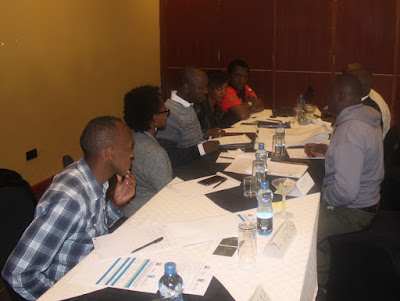By Bob Aston
Speaking during the opening of the workshop, Mr. Noah Lusaka, ALIN Projects Manager noted that the organization has been involved in improving farmer’s access to knowledge and skills through various Maarifa Centres in Kenya, Uganda, and Tanzania.
During the workshop, a
lot of emphasis was on the importance of soil analysis as an aid to assessing
soil fertility and plant nutrient requirements and management as well as
adoption of best agricultural practices as the best ways of reversing the
decline in maize production.
The Arid Lands Information Network (ALIN) through
Ng’arua Maarifa Centre in collaboration with the Ministry of Agriculture, Livestock,
and Fisheries held a two-day workshop on Maize Value Chain at Olivia
Court Motel, Sipili in Laikipia West Sub County on November 25-26, 2015.
A total of 85 farmers drawn
from Ol-Moran Ward attended the workshop. Its aim was to enhance farmer’s
production skills on maize value chain, to share production and marketing
experiences, to enhance systematic record keeping by maize farmers, to improve
cereals aggregation and to reduce post-harvest grain losses.
 |
| Farmers keenly following proceedings during the workshop |
Speaking during the opening of the workshop, Mr. Noah Lusaka, ALIN Projects Manager noted that the organization has been involved in improving farmer’s access to knowledge and skills through various Maarifa Centres in Kenya, Uganda, and Tanzania.
He said that in Ol-Moran
Ward the organization is promoting Maize, tree tomato and tomato value chains. Through
a participatory approach in 2013, farmers had identified the three value chains as the priority areas in the ward.
“We have been organizing
workshops and field days for farmers in the three value chains. We expect that
the information gathered by farmers will help them adopt best agricultural
practices and thus realize better returns,” said Mr. Lusaka.
He said that ALIN aims to
strengthen the three value chains and ensure farmers play an active role. He noted that the organization is keen in promoting the value
chain approach as this can promote inclusive economic growth.
Some of the challenges
listed by farmers included high input cost, frequent droughts, substandard inputs, low
soil fertility, human-wildlife conflict, lack of access to appropriate
information, difficulty in accessing credit facilities, high cost of unskilled
labour, pests and diseases, and high post-harvest losses.
The Ministry of
Agriculture, Livestock, and Fisheries noted that land under maize cultivation
in Ol-Moran Ward has been increasing while production has been declining over the
years. Most farmers noted that they are harvesting an average of 10-18 bags per
acre.
 |
| Mr. Kipyegon Kipkemei from EAGC addressing the farmers |
Mr. Kipyegon Kipkemei
from the Eastern African Grain Council (EAGC)
urged farmers to aggregate their cereals instead of selling cheaply to traders.
He said that EAGC is working with cereal banks in the ward to ensure that they
receive Warehousing Receipting System certification.
”Warehousing Receipting
System helps in mobilizing agricultural credit by creating secure collateral
for farmers. It also ensures better storage facilities as well as reduced risks
in the agricultural markets,” said Mr. Kipkemei.
He said that farmers have
the option to sell when they can get the best price for their cereals. This
reduces exploitation during the harvest season when the farm gate prices are
low.
The farmers learned about
production practices and management, agribusiness and value addition, soil
management, SOKO+ sms
platform, warehousing receipting system (WRS), pests and disease control,
harvesting and post-harvest management, maize record keeping system, storage,
and storage facilities, and drying, shelling and grading.










